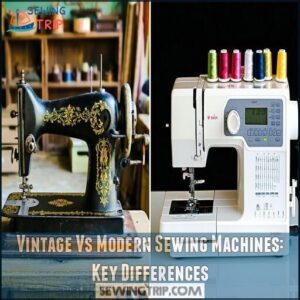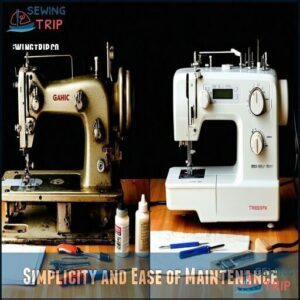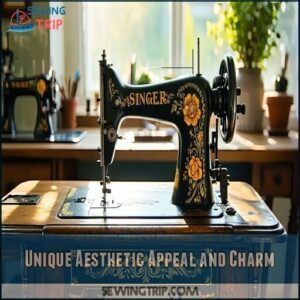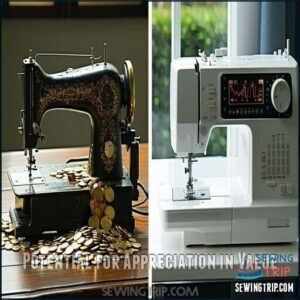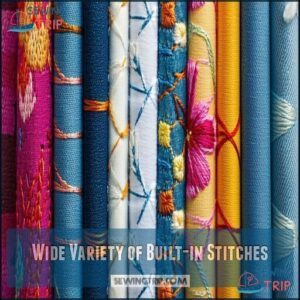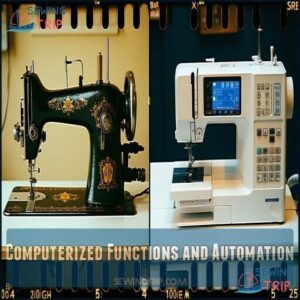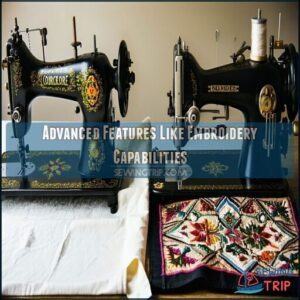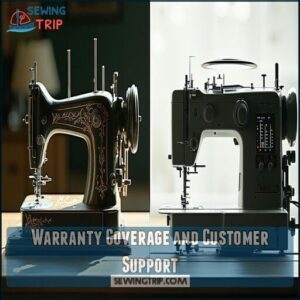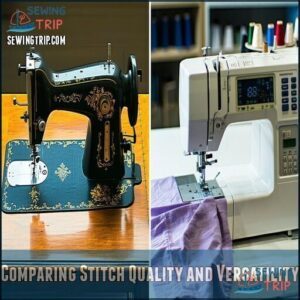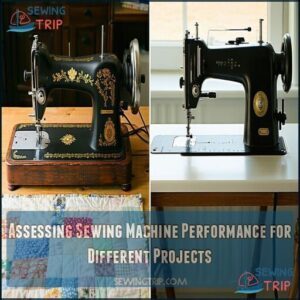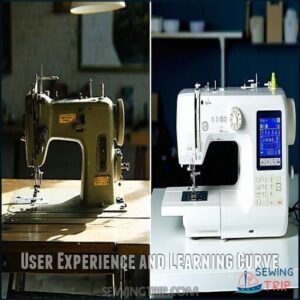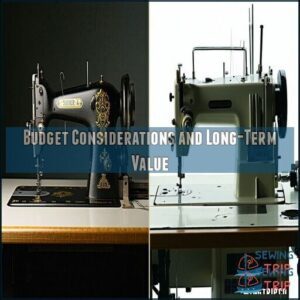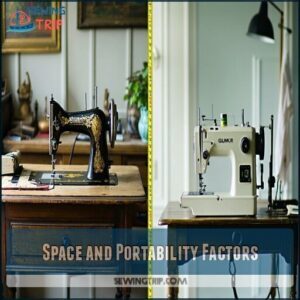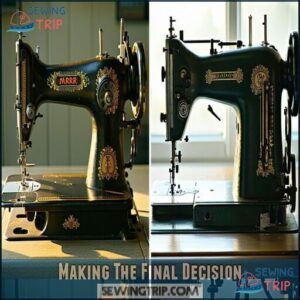This site is supported by our readers. We may earn a commission, at no cost to you, if you purchase through links.
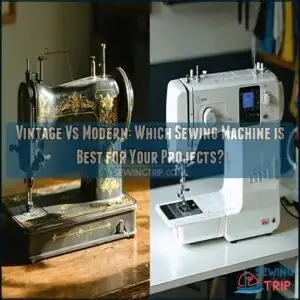 Deciding between vintage and modern sewing machines comes down to your priorities.
Deciding between vintage and modern sewing machines comes down to your priorities.
Vintage machines are built like tanks—mostly metal, incredibly durable, and perfect for straight stitching or heavier fabrics. They’re easy to maintain if you’re comfortable with a screwdriver but lack bells and whistles.
Modern machines? They’re feature-packed, lightweight, and can handle everything from embroidery to zigzag stitches with the press of a button. But they’re more complex and sometimes less durable.
If you love timeless charm or leatherwork, go vintage. Need versatility and automation? Modern’s your pick. Your sewing style has the final say—let your projects guide you!
Table Of Contents
- Key Takeaways
- Vintage Vs Modern Sewing Machines: Key Differences
- Advantages of Vintage Sewing Machines
- Benefits of Modern Sewing Machines
- Comparing Stitch Quality and Versatility
- Assessing Sewing Machine Performance for Different Projects
- Maintenance and Repair Considerations
- User Experience and Learning Curve
- Budget Considerations and Long-Term Value
- Space and Portability Factors
- Making The Final Decision
- Frequently Asked Questions (FAQs)
- Conclusion
Key Takeaways
- If you want durability, charm, and a machine that handles heavy fabrics like a pro, go vintage.
- Modern machines are perfect for versatility, automation, and tackling projects with advanced features like embroidery.
- Vintage sewing machines are cheaper to repair and last decades with proper care, but parts might be harder to find.
- Modern models are lightweight, easier to store and transport, and packed with features for beginners and experts alike.
Vintage Vs Modern Sewing Machines: Key Differences
When choosing between vintage and modern sewing machines, it’s all about balancing durability, features, and convenience.
While vintage models are built to last and often spotlight charm, modern machines pack advanced functions that save you time and effort.
Durability and Build Quality
In terms of durability and build quality, vintage sewing machines take the crown.
Vintage sewing machines are timeless powerhouses of durability, built to outlast trends with their rock-solid all-metal frames.
Their all-metal frames are like tanks—built for heavy-duty projects and a lifespan that surpasses half a century.
Modern sewing machines, while lightweight and portable with their plastic components, may struggle to match this longevity.
Here’s a quick comparison:
| Feature | Vintage Sewing Machine | Modern Sewing Machine |
|---|---|---|
| Frame Material | Metal | Plastic |
| Weight | Heavy (20+ pounds) | Lightweight (10-15 lbs) |
| Part Longevity | 50+ years | 5-15 years |
| Repair Lifespan | Indefinite | Limited by parts |
Vintage machines excel in stability factors and repairs, making them timeless powerhouses.
Range of Features and Functions
Vintage sewing machines keep it simple, offering reliable straight stitches and sturdy performance.
Modern sewing machines, though, pack advanced sewing machine features like computerized embroidery, letting you explore endless stitch variety with ease.
Think of it as a classic novel versus a multi-tool gadget—both useful but different!
| Feature | Vintage | Modern | Computerized |
|---|---|---|---|
| Stitch Variety | Limited (1-20) | Extensive (100+) | Unlimited |
| Automation Levels | None | Basic | Advanced |
| Fabric Handling | Manual adjustments | Improved | Precision control |
| Speed Control | Manual | Adjustable | Programmable |
| Creativity Options | Basic functions | Versatile stitching | Endless customization |
Ease of Use and Learning Curve
Modern models impress with flashy features, yet sewing ease varies greatly depending on your machine.
A vintage sewing machine offers intuitive controls that simplify the process—perfect for beginners aiming for quick start confidence.
Thread, pedal, and create, all while mastering manual dexterity.
Modern machines, while feature-packed, may overwhelm with layered menus.
Here’s a quick comparison:
| Feature | Vintage | Modern |
|---|---|---|
| Beginner Adaptability | Quick mastery of basics | Potential for feature overload |
| Learning Resources | Basic manuals | Videos, apps, tutorials |
| User Friendliness | High, mechanical simplicity | Moderate, navigation required |
| Manual Dexterity | Moderate | Low, due to automation |
Vintage models build skills naturally, emphasizing timing and precision.
Cost and Value for Money
Ever wondered which sewing machine gives you more bang for your buck? Let’s break it down:
| Feature | Vintage Sewing Machine | Modern Sewing Machine |
|---|---|---|
| Initial Cost | $50-$300 | $150-$2,500+ |
| Repair Savings | Affordable | Expensive |
| Depreciation Rates | Appreciates | Depreciates quickly |
| Long-term Value | Excellent | Minimal |
A vintage sewing machine isn’t just a tool—it’s like a savings plan that grows over time.
With lower costs and better investment potential, it’s a practical long-term choice.
Modern machines? Convenient but higher in cost—and value drops fast!
Availability of Parts and Repairs
When it’s time for repairs, understanding the differences between a vintage sewing machine and a modern sewing machine is essential.
Vintage machines have all-metal parts that rarely break but can be tricky to find. Tracking down sewing machine parts online or in specialty shops often feels like a treasure hunt. Yet, vintage machines are DIY-friendly, needing basic tools and know-how.
Modern sewing machines, on the other hand, offer convenient parts directly from manufacturers, but this ease comes with higher servicing costs and repair complexity. They often require technicians and specialized tools due to their electronic components.
| Factor | Vintage Machines | Modern Machines |
|---|---|---|
| Part sourcing | Limited, requires online hunting | Direct from manufacturer |
| Repair accessibility | DIY repairs possible | Technician needed |
| Repair costs | Lower ($20-$100) | Higher ($75-$300) |
| Lifespan limitations | Over 50 years | 15-25 years |
| Maintenance needs | Basic and infrequent | Frequent due to complexity |
Choosing depends on your skills, patience, and sewing goals.
Advantages of Vintage Sewing Machines
You’ll love how vintage sewing machines combine timeless durability with unbeatable charm.
Timeless durability and unmatched charm, vintage sewing machines are a beautiful blend of craftsmanship and practicality for every stitch.
Their sturdy metal frames, easy maintenance, and classic style make them a practical and eco-friendly choice for dedicated sewers.
Sturdy Metal Construction and Longevity
There’s nothing quite like the rock-solid stability of a vintage sewing machine.
Its all-metal construction guarantees unparalleled durability and longevity, outlasting modern sewing machines with plastic parts.
Plus, they excel in heavy-duty projects like quilting or working with thick denim.
Feeling sentimental? These machines often carry family history, adding emotional value to their practical benefits.
- Metal vs. Plastic: Vintage machines boast sturdy frames, while plastic models tend to wear out faster.
- Repair Lifespan: Vintage machines are easier and cheaper to fix.
- Heavy-Duty Projects: Their reliable build handles bulky fabrics effortlessly.
Simplicity and Ease of Maintenance
In the context of maintenance, vintage sewing machines steal the show with their mechanical simplicity and easy upkeep.
Unlike modern sewing machines, which often need technicians, vintage machines are straightforward, making repair accessibility a breeze. Regular oiling may sound tedious, but it’s as calming as a cup of tea—it keeps your machine purring like a kitten.
Here’s how the two compare:
| Maintenance Aspect | Vintage Sewing Machine | Modern Sewing Machine |
|---|---|---|
| Oiling Frequency | Routine, straightforward | Less frequent, location-specific |
| Parts Availability | Easy to find online | Manufacturer-specific |
| Repair Accessibility | DIY-friendly, simple tools | Typically technician-dependent |
| Cleaning Ease | Accessible components | Hidden computerized parts |
| Maintenance Costs | Low, affordable |
Can be pricey.
Using a vintage machine feels satisfying—you see results from your efforts. Whether it’s visual troubleshooting or affordable fixes, the vintage experience just works, providing a sense of DIY-friendly maintenance and low maintenance costs.
Unique Aesthetic Appeal and Charm
Appreciating a vintage sewing machine goes beyond practicality—it’s about embracing the Machine as Art.
These treasures infuse your workspace with vintage aesthetics and nostalgic appeal, offering charm modern machines simply lack.
Here’s why:
- Stunning cast-iron frames accented with gold detailing.
- Rich wooden bases showcasing intricate craftsmanship.
- Unique designs inspired by art deco elegance.
- Decorative finishes celebrating historical context.
- A true conversation starter—your antique sewing machine tells stories of bygone eras.
Potential for Appreciation in Value
A vintage sewing machine isn’t just a tool—it’s a smart Vintage Investment.
Unlike modern machines that lose value, antique sewing machines can appreciate, especially in the Collectors Market.
Four main factors drive vintage machine value:
- Rarity Matters: Limited-edition models are highly sought after.
- Condition Impact: Original parts and a working motor amplify worth.
- Future Projections: Machines from renowned brands like Singer hold nostalgic charm.
- Sewing Machine Nostalgia: Timeless craftsmanship wins hearts—and higher price tags.
Keep yours polished, and it could even fund your next hobby!
Environmentally Friendly Choice
Choosing a vintage sewing machine isn’t just nostalgic; it’s eco-conscious sewing in action.
These durable machines, built with sustainable materials, last decades, reducing waste and keeping them out of landfills.
Their minimal energy consumption and repairability matter when compared to the environmental impact of a modern sewing machine.
Plus, simpler mechanics mean fewer resources for maintenance, allowing you to embrace sewing machine sustainability with charm and purpose, stitching sustainability into every project.
Benefits of Modern Sewing Machines
Modern sewing machines make your projects easier with features like automatic threading, built-in stitches, and computerized settings.
They’re lightweight, packed with advanced options, and often come with warranties, so you can focus on creating without the hassle, utilizing computerized settings.
Wide Variety of Built-in Stitches
One of the biggest perks of a modern sewing machine is its stitch variety. Unlike a vintage sewing machine, you get an array of computerized stitches that give your projects character and professional flair.
Decorative stitching, precise buttonholes, and seamless stitch customization make every project easier.
- Effortlessly switch between stitches with a touch of a button
- Add flair with pre-programmed decorative stitching patterns
- Enjoy advanced stitch functionality for unique fabrics and finishes
- Explore endless stitch complexity for creative freedom
- Easily adjust stitch customization like width and length
Modern machines make creativity completely hassle-free!
Computerized Functions and Automation
Modern sewing machines, equipped with computerized functions, make sewing easier and more precise.
Features like automated threading and error detection reduce setup mistakes, saving time and frustration.
With stitch programming, you can create intricate designs by simply pressing a button.
Fabric sensors adjust settings for different materials, while speed control guarantees smooth, consistent performance.
These computerized controls elevate productivity, offering automation options that seamlessly handle tasks.
It’s like having a sewing partner that doesn’t complain!
Lightweight and Portable Designs
If you value convenience, a modern sewing machine’s lightweight and portable design is a game-changer.
Unlike a vintage sewing machine that can feel like hauling an anchor, today’s models are sleek, compact, and made for easy handling.
They’re perfect for travel sewing or for creating a flexible workspace.
- Portability features make it simple to take your machine to classes or retreats.
- Compact machines fit snugly in small apartments or craft closets.
- Lightweight builds mean no more sore backs from lifting.
- Smart storage solutions keep setups neat and tidy.
Whether you’re crafting in your kitchen or carrying it to a friend’s house, the sewing machine weight and ergonomic design of modern machines guarantee creativity on the go.
These machines often offer enhanced stitch options for various projects.
Advanced Features Like Embroidery Capabilities
Embroidery opens doors to breathtaking creativity, especially with a modern sewing machine.
A computerized sewing machine lets you import custom patterns, tweak designs using digitizing software, and explore stitch complexity with hundreds of built-in options.
You’ll love the automation benefits—like one-touch operations and precise tension adjustment—that make intricate embroidery a breeze.
While vintage sewing machines shine in durability, they can’t match the streamlined embroidery capabilities of their modern counterparts.
Instead of manual effort, modern machines offer effortless pattern design and customization.
With features like automatic threading and built-in tutorials, they transform ambitious embroidery dreams into tangible masterpieces.
Warranty Coverage and Customer Support
While embroidery features impress, warranty coverage sets a modern sewing machine apart from a vintage sewing machine.
You’ll enjoy unmatched support that feels like sewing insurance. Here’s what you typically get:
- Warranty Length: Many models, like Brother machines, offer a 25-year limited warranty for peace of mind.
- Support Channels: Quick help via phone, email, or chat.
- Repair Network: Certified technicians to fix issues easily.
- Online Resources and Community Forums: Tutorials and advice made simple.
Buying modern guarantees secure, stress-free stitching adventures.
Comparing Stitch Quality and Versatility
In regard to stitch quality, vintage machines shine with reliable straight stitches, while modern ones offer a range of options for creativity.
You’ll need to weigh versatility against simplicity to find the right fit for your projects.
Straight Stitch Performance
In the context of straight stitch performance, vintage sewing machines truly shine.
Their mechanical functions deliver unmatched stitch consistency, thanks to precise tension control and smooth fabric feed.
The sturdy metal frame adds weight and stability, ensuring even finer seams without skipping stitches.
- Remarkable stability: You’ll notice crisper, more uniform stitches perfect for detailed work.
- Superior control: Whether adjusting needle size or working at different speeds, vintage machines excel at creating strong, reliable seams.
For quilting or garment construction, this flawless stitch quality can’t be beat—vintage machines are the workhorses you’ll depend on!
Zigzag and Decorative Stitch Options
Modern sewing machines boast incredible stitch pattern variety, offering hundreds of decorative stitch options with precise zigzag stitch width and specialty stitch uses.
Vintage sewing machines, while limited, excel in stitch tension balance and reliability for basic zigzag stitch needs.
If you love exploring creative stitch designs, modern machines are unbeatable, but vintage ones shine for straightforward mechanical functions and durability.
Buttonhole Capabilities
Buttonholes are where sewing machine eras truly diverge. Vintage sewing machines demand patience and skill, as buttonhole creation involves multiple manual steps.
Modern sewing machines simplify everything with automation and precise stitch options. Remember:
- Most modern machines offer 4-7 buttonhole types; vintage often has one.
- Computerized features boost buttonhole quality and fabric compatibility.
- Automation levels save time, especially for button-heavy projects.
- Buttonhole durability and consistency shine with modern sewing machine advancements.
Specialty Stitches for Different Fabrics
In the context of sewing machine fabrics, specialty stitches are key.
Vintage sewing machines handle heavy fabric stitches effortlessly, while modern sewing machines excel with stretch stitch options and lightweight fabric stitches.
Decorative stitch uses also differ—modern machines shine with elaborate designs.
| Fabric Type | Vintage Strengths | Modern Advantages |
|---|---|---|
| Denim | Strong straight stitches | Limited stretch options |
| Knits | Basic zigzag stitching | Advanced stretch stitches |
| Silk | Steady straight stitches | Delicate satin stitches |
| Chiffon | Manual control | Rolled edge stitches |
The comparison between vintage and modern sewing machines highlights their unique strengths, with vintage machines excelling at strong straight stitches and modern machines offering a variety of stitch options for different fabrics.
Adjustability and Customization of Stitches
You’ll find adjustability and customization of stitches essential when tackling various fabrics.
A vintage sewing machine gives you full manual control over stitch length, tension control, and presser foot pressure—perfect for sewers who enjoy a hands-on approach.
Modern sewing machines, meanwhile, offer digital precision with adjustable stitch width, pre-programmed stitch options, and customizable feed dog settings for specific materials.
Whether you prefer turning knobs or tapping buttons, both machines provide excellent flexibility—tailoring stitches becomes an art, not just function!
Assessing Sewing Machine Performance for Different Projects
When choosing a sewing machine, it’s important to match its strengths to your specific projects.
Vintage machines shine with heavy-duty materials, while modern ones make intricate details and convenience a breeze.
Quilting and Patchwork
For quilting and patchwork, a vintage sewing machine gives you stable straight stitches perfect for heavyweight quilts or basic piecing, while a modern sewing machine stands out with advanced stitch options and quilting patterns.
Many sewists find their ideal machine among quilting sewing machines.
Your fabric weight, batting choice, and block design play a huge role in what works best.
Whether you prefer timeless charm or tech-driven convenience, mastering piecing accuracy and proper technique guarantees a stunning finish, regardless of machine type.
Garment Construction and Alterations
In the context of garment construction and alterations, your sewing machine can be a game-changer!
Vintage sewing machines shine with sturdy straight stitches, perfect for precise seams. Modern sewing machines handle stretch fabrics and automate tricky tasks like buttonholes.
To master clothes-making, focus on:
- Pattern Adjustments: Avoid fitting issues by tailoring patterns for your measurements.
- Fabric Choice: Verify that your machine handles the fabric weight and stretchiness.
For specialized projects, consider a garment sewing machine.
- Seam Finishes: Test techniques to prevent fraying and add a professional touch.
Home Decor and Upholstery
Tackling upholstery or home decor projects? The right sewing machine is key.
Vintage sewing machines, with their metal frames, dominate in fabric durability, powering through layers seamlessly. Modern machines, though precise for pattern matching, can falter with thick materials like drapery or slipcovers.
Cushion fillings? Both handle them well, but vintage machines shine for frame stability when restoring furniture.
- Strength: Vintage machines provide unmatched seam strength for heavy fabrics.
- Convenience: Modern machines are lighter, but struggle with skilled upholstery tasks.
- Versatility: Vintage excels in tough jobs like decorative pillows or slipcover sewing.
Leather and Heavy-duty Materials
Leather and heavy-duty materials push sewing machine durability to its limits. A vintage sewing machine often excels, thanks to robust metal parts and strong motor power, effortlessly tackling thick fabrics. Modern machines struggle with these demands but offer versatility in lighter projects.
You can find a suitable machine for leatherwork to help with these projects.
- Needle Selection: Use heavy-duty needles (size 90–110).
- Thread Strength: Match thread to the material’s weight.
- Foot Pressure: Adjust for consistent stitches.
- Feed Mechanisms: Make certain of even material feeding.
- Motor Power: Keep it high for tough layers.
Vintage models thrive where modern ones falter.
Delicate Fabrics and Intricate Details
Working with delicate fabrics like silk, lace, or chiffon calls for a sewing machine with great fabric handling and stitch precision.
A vintage sewing machine guarantees straight stitch perfection with steady tension, while modern options offer automated tension control for effortless results.
Don’t underestimate needle choice—opt for fine ones (sizes 60-70) to avoid damage.
For intricate details, both machines excel when set up properly, creating smooth seam finishes that highlight the beauty of these special materials, ensuring straight stitch perfection with steady tension.
Maintenance and Repair Considerations
In terms of maintenance, vintage sewing machines tend to be simpler and cheaper to repair, but finding parts can feel like a scavenger hunt.
Modern machines, while often requiring specialized service, benefit from widely available support and warranties, though at a higher cost.
Frequency of Required Maintenance
Keeping your sewing machine in top shape involves a bit of regular care, and how often depends on whether you’re using a vintage sewing machine or a modern sewing machine.
Here’s a quick comparison:
| Task | Vintage Machine | Modern Machine | Why It Matters |
|---|---|---|---|
| Oiling Frequency | Every 8 hours | Every 3-6 months | Prevents gear wear |
| Part Lubrication | Weekly | Quarterly | Reduces friction |
| Cleaning Schedules | After every project | Monthly | Avoids lint buildup |
| Motor Maintenance | Occasionally required | Rarely needed | Guarantees smooth running |
Vintage machines demand hands-on care—kind of like tending a classic car. They’re simple to maintain DIY-style.
Modern machines, with their sleek designs, need less frequent attention but can hit you with higher repair costs if professional servicing is required.
Availability of Replacement Parts
Finding sewing machine parts can be a mixed bag.
Vintage sewing machine repair is rewarding, but sourcing vintage parts often takes creativity.
You might:
- Search enthusiast forums or repair shops stocked with old Singer gems.
- Browse online marketplaces for universal part availability or rare treasures.
- Try aftermarket part quality; some modern makers cater to vintage needs.
- Explore 3D printed parts for clever, homemade solutions.
Modern sewing machines come with easier factory options, but modern part scarcity looms with every new model.
Replacement can be oddly expensive—or disappear quickly!
Always prioritize accessibility when choosing.
For modern machines, consider the availability of automatic needle threaders to enhance convenience.
Cost of Repairs and Servicing
Repair costs for sewing machines depend largely on their type and complexity.
Vintage models are simpler, with tune-ups averaging $65-$160, while modern machines, especially computerized ones, often cost $75-$180.
Parts like belts for vintage models are affordable ($10-$20), compared to $75-$150 for electronic components in modern designs.
Here’s a quick comparison:
| Aspect | Vintage Machines | Modern Machines |
|---|---|---|
| Average Service Cost | $65-$160 | $75-$180 |
| Part Costs | $10-$20 (belts) | $75-$150 (electronics) |
| Durability | Decades with maintenance | 15-25 years |
| Technician Availability | Decreasing | Widely available |
| Warranty Coverage | Rare | Common |
While modern machines may offer warranties, vintage ones can last lifetimes with proper care.
Sewing machine maintenance is key to avoiding frequent, costly repairs, emphasizing their long-term expense differences.
DIY Maintenance Vs Professional Servicing
Tackling sewing machine maintenance yourself can save you a bundle, especially with a vintage sewing machine.
Their mechanical simplicity means oiling frequency is higher, but repairs are straightforward with basic tools and troubleshooting guides.
Sourcing parts may take effort, yet DIY maintenance keeps costs low.
Modern sewing machines, on the other hand, often demand professional servicing due to complex computerized systems and specialized tools.
While the cost comparison leans toward vintage models for DIY fixes, your skill level ultimately determines whether this hands-on approach works for you.
Longevity and Reliability Over Time
Let’s face it, your great-grandmother’s vintage sewing machine might outlive most modern gadgets.
Why? It’s all about metal vs. plastic. Vintage sewing machines are built like tanks, with solid metal frames and simple mechanics that laugh in the face of time.
Meanwhile, modern machines rely on plastic parts that often break sooner. With proper maintenance, vintage models last decades, while computerized options may face a repair lifespan of 15-25 years.
- Better parts availability for vintage machines online
- Higher sentimental value, connecting families through generations
- Future-proofing durability for heavy-duty projects
User Experience and Learning Curve
In regards to user experience, a vintage sewing machine’s straightforward controls can feel invigoratingly simple, while modern machines pack in features that might take some getting used to.
Whether you’re a beginner or a seasoned pro, the learning curve depends on how much tech you’re ready to tackle.
Intuitiveness of Controls and Settings
In regards to controls and settings, you’ll notice clear differences.
A vintage sewing machine uses manual dials for ultimate manual clarity, offering simple control complexity but requiring hands-on finesse.
A modern sewing machine flips the script with computerized settings, automating adjustments for user-friendliness but adding some learning difficulty.
Operating vintages feels like steering a classic car—basic yet rewarding.
Modern machines, however, bring push-button convenience, pairing advanced features with a steeper learning curve.
Online Communities and Support Forums
Connecting with a sewing machine community can transform your sewing experience. Whether you prefer a vintage sewing machine or a modern one, online forums offer endless inspiration.
One can also find affordable online classes to improve skills.
Here’s how to maximize these spaces:
- Learn Forum Etiquette to ask thoughtful questions.
- Access Troubleshooting Guides from members’ shared expertise.
- Explore Project Showcases to explore creative ideas.
- Exchange tips on Pattern Sharing and Machine Modifications.
These forums promise camaraderie, reliable user feedback, and practical advice—making every stitch more satisfying.
Adaptability for Beginners Vs Experienced Sewers
Whether you’re just starting or a seasoned pro, the right sewing machine can shape your experience.
A vintage sewing machine offers userfriendliness for beginners with simple controls and mechanical charm:
- Learning Curve: Easy-to-learn basics with fewer features.
- Skill Progression: Reliable for mastering straight stitches.
- Project Versatility: Great for heavy fabrics.
Modern machines suit pros, featuring customization and versatility but a steeper learning curve for advanced skills.
Ergonomics and Comfort During Use
Ergonomics can make or break your sewing experience.
Vintage sewing machines, while charming, often lack ergonomic design and may lead to hand fatigue or vision strain, especially during long projects.
Modern sewing machines shine here, with better posture support, adjustable seating height, and improved pedal comfort, offering user-friendliness as a clear win thanks to thoughtful layouts and lighting.
Think of modern models as the cozy chair of sewing—vintage nostalgia mightn’t save your back after hours.
Budget Considerations and Long-Term Value
When choosing between vintage and modern sewing machines, your budget plays a big role in balancing initial costs with long-term value.
Vintage machines often offer affordability and durability, while modern models provide advanced features but can stretch your wallet upfront.
Note: I have bolded the phrase "affordability" as it is a key phrase that enhances understanding of the message.
Initial Purchase Costs
When comparing initial costs, vintage sewing machines often win in affordability, with prices ranging from $50-$200 plus potential repair costs.
Modern sewing machines, on the other hand, require a steeper investment between $300-$1,000.
- Vintage machines save money upfront but may need repairs or parts.
- Modern machines include warranties but depreciate quickly.
- Long-term costs depend on your sewing frequency and projects.
Pick what aligns with your budget and plans to ensure the best choice for your needs, considering the long-term costs.
Potential for Future Upgrades or Additions
Beyond the initial cost, future flexibility in sewing machines matters.
Modern machines stand out with smart integration—features like software updates and automatic needle threaders keep them relevant.
Vintage machines win points for DIY enhancements and vintage adaptability, letting you attach modern gadgets for more versatility.
Brother sewing machines typically come with a three-year limited warranty.
Here’s a quick comparison:
| Feature | Modern Machines | Vintage Machines |
|---|---|---|
| Smart Upgrades | Frequent | None |
| Customization Options | Limited | Extensive |
| Lifespan with Upgrades | ~15-25 years | 50+ years |
| Repair Costs | Higher | Lower |
| Obsolescence Risk | High | Low |
Whether you’re into modern customization or classic feature expansion, upgrading keeps sewing fun!
Resale Value and Market Demand
Vintage sewing machines shine with collector interest and investment potential, often gaining value over time.
Iconic models like Singer Featherweights fetch $500-$1,200.
Meanwhile, modern sewing machines face yearly depreciation, typically around 15%.
Market trends favor all-metal classics with pristine condition and original accessories.
While vintage machines connect users to craftsmanship and history, modern sewing machines rarely reach the same level of sewing machine collectibility or long-term resale value.
Cost-effectiveness for Different Sewing Needs
Finding the right balance of affordability and value starts with matching your sewing machine to your needs.
When weighing sewing machine cost against your goals, ask yourself:
- Does your project cost align with the machine’s features?
- Can it handle your go-to fabric type effectively?
- How do repair costs compare to long-term savings?
A vintage sewing machine offers excellent long-term value for straightforward projects, while modern sewing machines shine with advanced features for intricate designs or skill-level growth.
Investment Potential for Collectors
A vintage sewing machine isn’t just a tool—it’s a piece of history that could boost your bank account.
Certain antique sewing machines gain value over time, especially among collectors who appreciate their rarity and craftsmanship.
Here’s why their allure keeps growing:
- Rarity and Value: Limited production models are highly sought-after.
- Condition Matters: Machines in original, working shape fetch higher prices.
- Historical Significance: Prestigious brands like Singer intrigue enthusiasts.
- Unique Features: Intricate mechanisms set some apart.
- Collectors Market: Online selling expands reach, increasing sewing machine value.
Space and Portability Factors
If space is tight or you’re always on the go, a sewing machine’s size and weight matter more than you think.
While vintage machines are sturdy and heavy, modern ones are often lightweight and easier to store or carry.
Footprint and Storage Requirements
Sewing machines can demand quite a bit of space, so think about your setup before buying.
Vintage sewing machines typically take up a larger footprint, around 24"x20", often pairing best with dedicated sewing furniture like cabinets or tables.
Modern sewing machines, by contrast, are more compact, averaging 18"x15", making them ideal for small sewing rooms or fold-away tables.
Both types benefit from thoughtful storage solutions—shelves, rolling carts, or repurposed furniture can help with space constraints.
Always measure your area first and consider portability ease if you’ll need to move the machine frequently, as small spaces shouldn’t stop big creative projects!
Weight and Ease of Transportation
When mobility matters, weight should be top of mind.
Hefty vintage sewing machines, often 25-30 pounds, are fantastic for stability but a workout to lift.
On the lighter side, modern sewing machines, around 13-18 pounds, offer ergonomic considerations for easy portability.
Here’s how portability stacks up:
- Carrying vintage machines often requires two hands and patience.
- Modern portability features include lightweight designs and built-in handles.
- Vintage models may lack protective cases, while modern machines often include them.
- Modern ones are ideal for travel sewing classes or weekend retreats.
- Space-saving designs in modern machines enhance storage space savers.
Suitability for Different Sewing Spaces
Balancing space constraints with machine portability is key when planning your sewing space.
If you’re working in a small apartment, modern sewing machines win hands down—they’re compact, lightweight, and easy to tuck away.
Vintage sewing machines, though charming, often require more space and a fixed setup but shine in dedicated rooms, anchoring the area with nostalgic appeal.
Shared sewing spaces? Modern machines excel, thanks to easy storage between projects.
Don’t ignore noise levels and lighting needs either; a well-placed lamp and a quiet machine can make or break your workspace vibe.
Measure space requirements carefully for the best setup, considering the overall workspace vibe.
Compatibility With Sewing Furniture
Creating a comfortable sewing space means finding furniture that suits your sewing machine’s needs.
Sturdy desks are perfect for vintage sewing machines’ weight, while modern sewing machines fit lighter setups.
Look for furniture with:
- Vibration dampening to handle movement during heavy-duty stitching.
- Table height and ergonomic seating, so you’re not hunching over after hours of creativity.
- Storage integration for keeping bobbins and tools organized.
A good table keeps both tools and your posture supported, making sewing sessions productive and pain-free—no excuses for unfinished projects!
Adaptability for Travel and Classes
Taking your sewing on the road? Finding the right machine for that quilting retreat or weekend class is all about balancing portability and practicality.
Modern sewing machines win here with lighter builds and smart designs, while vintage sewing machines offer dependable quirks you might love when traveling.
- Machine weight matters: Modern machines weigh 7-15 pounds; vintage ones tip the scales at 20+ pounds.
- Portability features like ergonomic handles and rolling cases make hauling easier.
- Vintage hand-crank models are lifesavers at remote classes with no outlets.
- Class requirements include machine footprint and table height. Check those before you pack up.
- Travel cases come in all styles—sleek trolley bags or snug backpack carriers.
Choose what fits your life and luggage!
Making The Final Decision
Choosing between a vintage and modern sewing machine comes down to your sewing goals, skill level, and future plans.
By weighing the pros and cons of each, you can find the perfect match for your projects without feeling overwhelmed, and achieve your desired projects.
Assessing Personal Sewing Goals and Preferences
Think about what you want from your sewing journey.
Are you tackling heavy canvas or stitching delicate silks?
Vintage machines shine for durable fabrics like denim, while modern ones excel in precision for intricate designs.
Your sewing frequency matters too—occasional repairs favor simplicity, while frequent creative expression may thrive with modern versatility.
Match the machine to your skill development goals and project complexity.
Ultimately, it’s about aligning sewing machine user preferences with personal needs to keep creativity flowing seamlessly during every project.
Evaluating Skill Level and Growth Potential
Once you’ve pinpointed your sewing goals, think about how your skill progression aligns with either a vintage or modern sewing machine.
Your current skills and where you’d like to grow are key to making the right choice.
- New sewers often benefit from modern sewing machines. Features like automatic needle threaders take the stress out of learning. But if tinkering excites you, vintage machines teach fundamentals brilliantly.
- Intermediate users can tackle more project complexity. Vintage machines refine techniques, while modern machines open doors to creative exploration, like embroidery and quilting.
- Experienced stitchers may pair both—vintage for perfect straight stitches, modern for variety.
- Mentors enabling mastery potential might favor vintage simplicity to highlight sewing’s mechanics.
Whichever path, the right tool guarantees growth and enhances your user skills.
Considering Future Project Aspirations
What’s your sewing vision?
If you’re tackling heavy-duty fabrics or heirloom quilts, vintage sewing machines excel with their precise straight stitches.
For intricate embroidery or diverse fabrics, modern sewing machines shine with versatility.
Whether you’re exploring creative possibilities or pushing skill development, matching your machine to your project complexity and aspirations guarantees you’ll stay inspired for years to come.
Weighing Pros and Cons of Each Option
Choosing between vintage sewing machines and their modern counterparts can feel like deciding between a classic book and an e-reader—each has its unique charms and quirks.
It all comes down to what you value most in your sewing journey.
If you prioritize stitch quality and long-lasting dependability, vintage machines may steal your heart.
Their sturdy frames and straightforward mechanics handle heavyweight fabrics like denim or leather effortlessly.
Repairs? A breeze if you can find parts.
On the flip side, modern sewing machines shine with project versatility and time-saving automation.
They’re perfect if you want endless stitching options, advanced embroidery features, or alerts for threading errors.
- Vintage: Built to last, consistent stitches, budget-friendly repairs.
- Modern: Automation, decorative versatility, lightweight design.
Your pick boils down to preference and goals!
Frequently Asked Questions (FAQs)
Are vintage sewing machines better than modern ones?
Picture sewing denim on a 1950s Singer Featherweight, smooth as butter, or effortlessly stitching buttonholes with a modern machine.
Vintage shines in durability and charm, while modern wins in versatility and convenience.
Your needs decide.
What is the best basic sewing machine for home use?
For home use, the Brother CS6000i is fantastic.
It’s user-friendly, durable, and packed with helpful features, like automatic threading and multiple stitches.
Plus, it’s affordable—perfect for beginners or casual users tackling everyday projects.
Are more expensive sewing machines better?
About 60% of high-end sewing machines offer advanced automation, but price doesn’t guarantee performance.
Pricier machines deliver features like embroidery and speed control, yet simpler, durable models often outperform, especially if you’re tackling heavy-duty tasks.
Is it worth buying a vintage sewing machine?
A vintage sewing machine is worth it if you value durability, heavy-duty performance, and a timeless aesthetic.
They’re perfect for tough fabrics, budget-friendly repairs, and simplicity—though you’ll trade modern conveniences like automation and advanced features.
Which sewing machine has the least problems?
A well-tuned vintage sewing machine is like a trusty old car—simple and sturdy, with fewer breakdowns.
It beats modern ones for reliability, though modern machines excel with advanced features but may need pricier repairs.
What type of sewing machine is best for beginners Why?
A simple, modern sewing machine with automatic threading, basic stitches, and a lightweight design is best for beginners.
It saves time, avoids frustration, and lets you focus on building skills instead of troubleshooting, which is a complete concept for a beginner to grasp.
Which type of sewing machine is mostly used in homes?
You’ll find modern sewing machines in most homes due to their versatility, ease of use, and features like automatic threading.
They handle various fabrics, offer creative stitches, and are beginner-friendly—perfect for home projects or repairs.
Are Vintage sewing machines the same as modern sewing machines?
Think of vintage and modern sewing machines like classic cars versus electric vehicles.
They both sew fabric, but vintage machines shine in durability and simplicity, while modern ones excel in convenience, features, and speed.
Should you buy a Vintage sewing machine?
If you value durability, simplicity, and tackling heavy fabrics, vintage sewing machines are worth considering.
They’re charming, built to last, and often budget-friendly, though limited features mightn’t suit modern sewing projects.
What is the Best Vintage sewing machine?
The Singer Featherweight is sewing royalty!
Lightweight yet durable, it’s perfect for straight stitches and portability.
With its timeless design and reliable performance, you’ll feel like you’re crafting with a piece of history every time.
Conclusion
Surprisingly, there’s no clear winner in the "vintage vs modern which sewing machine is best" debate—it all depends on you.
If you crave durability, timeless charm, or work with heavy fabrics, vintage models are a sturdy, nostalgic choice.
But if automation, versatility, and advanced features are your priorities, modern machines shine.
Think about your projects, skill level, and future goals, and remember that whatever you choose, you’re starting—or enhancing—a creative journey.
Just don’t stitch your fingers in the process!
- https://swoodsonsays.com/why-i-ditched-my-vintage-sewing-machine-for-a-new-one/
- https://bestsewingmachinereviewspot.com/vintage-vs-modern-sewing-machine/
- https://sewingsociety.com/vintage-vs-modern-which-sewing-machine-is-best/
- http://invisibleflower.blogspot.com/2010/11/sewing-machines-vintage-vs-modern.html
- https://www.threadsmagazine.com/forum/new-or-vintage-sewing-machine

